What to expect on a 3 day tour of Bolivia’s Salt Flats
Are Bolivia’s salt flats worth visiting? Bolivia’s salt flats are the largest in the world – at over 10,000 square kilometres – plus there’s a wealth of history to be discovered.
Here’s how our three day tour of Salar de Uyuni (Bolivian Salt Flats) with Red Planet went.
TL;DR: Skip the story and get to the details.
Day 1 on Bolivia’s Salt Flats tour: A graveyard, salt flats, Isla Incahuasi and a beautiful sunset
After a sleepless night on an overnight bus from La Paz to Uyuni, the bus comes to a sudden stop just before 6am. We aren’t told why, we just sit without the engine on for about 45 minutes until the door randomly opens and breakfast is served – an apple juice and a cheese and ham sandwich.
We arrive in Uyuni at 7:15am, and when we step off the bus Red Planet are there waiting to drive us to their headquarters in town.
We have some time to kill before we’re due to leave at 11am, so our guide suggests we find props for perspective photos. I find a brontosaurus from a store nearby.
When we climb into our allocated Land Cruiser, I look at the odometer and see our 4×4 had done more than one million kilometres. Gulp. I hope we make it to Chile in this thing.
We’re lucky to have our tour guide, Hector, in the car with us. As Bon Jovi plays through the speakers, he turns and asks if it’s okay to turn it up louder. I immediately know we’re going to be good friends.
Uyuni train graveyard
At the train graveyard near the start of Bolivia’s Salt Flats we listen as Hector gives us a brief history lesson. In the 1940s this train line was left for dead when the mining industry collapsed. There are lots of minerals ripe for mining in Salar de Uyuni, including borax, but the government have been careful not to allow exploitation by foreign mining companies.
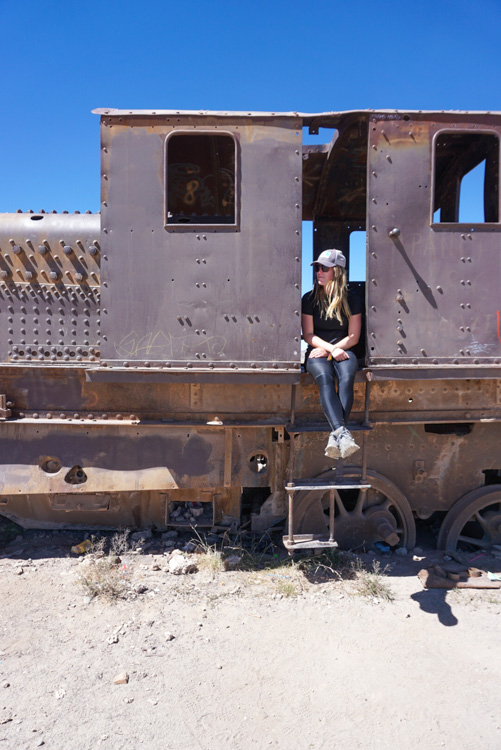
Leaving the train graveyard, I look to see how fast we’re driving on the highway to Colchani village and notice the speedometer is broken. I guess there’s no concern for being caught speeding in the wilderness, so why bother fixing it?

Colchani village
We arrive in Colchani village for lunch where we learn about the salt production process. They produce 5,000kg of salt each day and package it up to send all around Bolivia. Salt bricks from the wet and dry season are distinguishable by the colours of the lines – white or black.
For lunch we eat mashed potato, llama, a tomato/cucumber salad and a cupcake.
Entering the salt flats
After lunch we enter the famous salt flats. The salt flats were formed after several prehistoric lakes evaporated over the last 40,000 years. The vast salt crust is extraordinarily flat, with thickness variations within one meter over the entire 10,000 square kilometres. In the wet season, a thin layer of water creates the world’s largest mirror. We’re lucky to be here in April to experience the phenomenon – though typically the wet season runs from November to March.
At the beginning of the salt flats there is a small island where we can hear many of the world’s flags cracking in the wind. I desperately search for an Australian flag and I’m shocked to see nobody has placed one here.
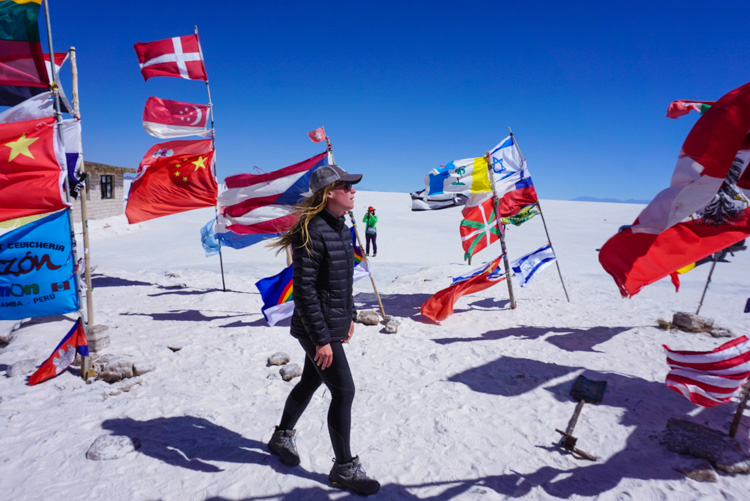
For an hour we drive further into the salt flats, where we suddenly stop to take perspective photos on what looks like another planet.
Taking these photos is much harder than I’d imagined, but Hector is really helpful with camera positioning and makes sure the group get some great shots.
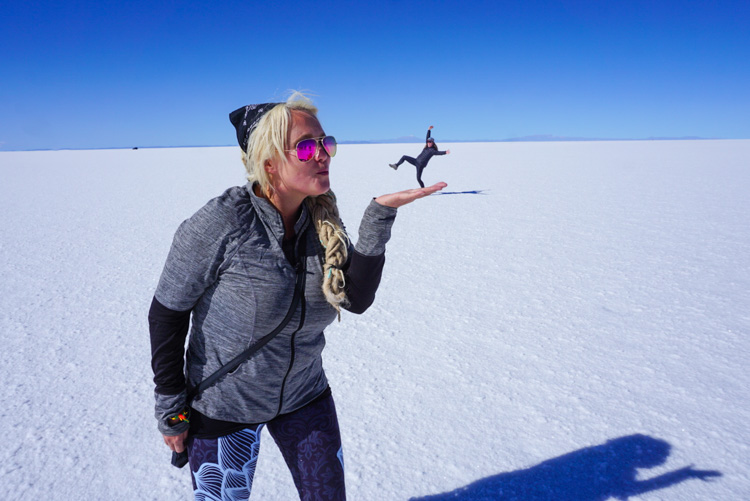
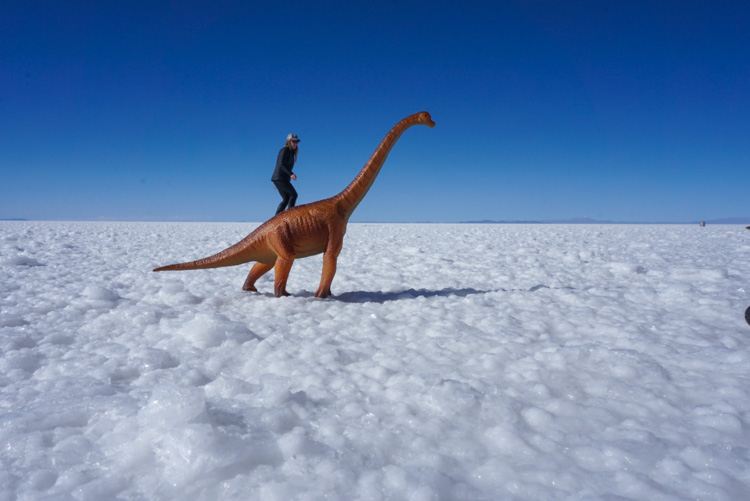
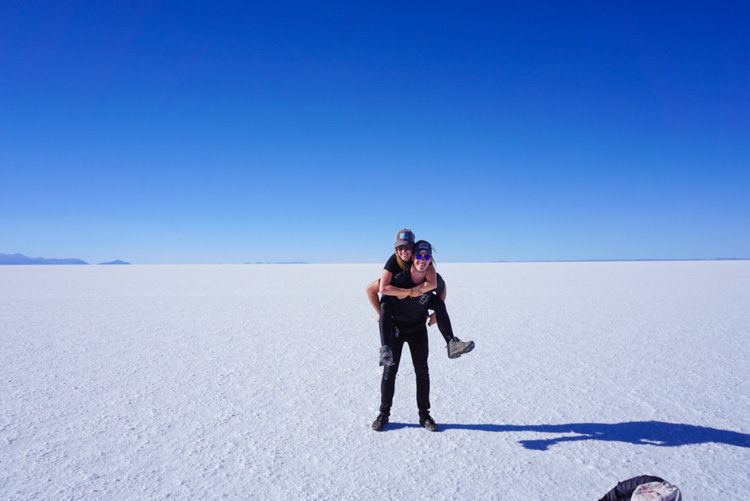
Isla Incahuasi
At the heart of Salar de Uyuni lies Isla Incahuasi, or “House of the Inca”.
We each pay the entry fee and walk around the island, stopping to learn along the way with Hector. Before this became a popular tourist destination, Isla Incahuasi was a place of rest for local people crossing the flats.
Hector teaches us about a ritual for pachamama or “Mother Earth” and tells us the rocky outcrop we’re standing on is the remains of an ancient volcano, which is now covered in cactus plants.
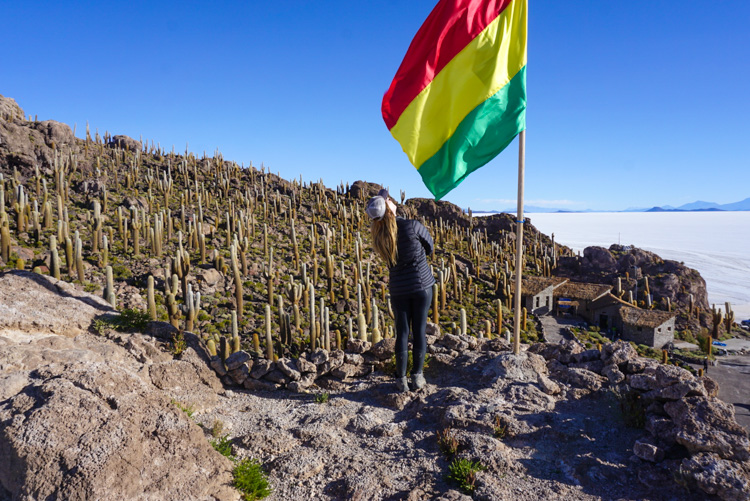
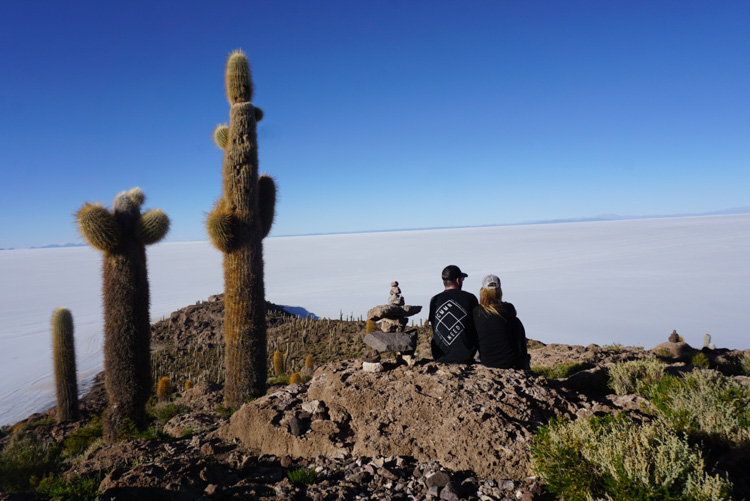
We continue the drive to our salt hotel while rock music blasts through the speakers. When the sun begins to set, we stop to enjoy the magic of the sky changing colour on the flats, and experience the spectacular reflection all around us.
Handy tip: Do not walk barefoot. The salt is sharp like knives, and really hurts to walk on. Wear a pair of slip on shoes or waterproof hiking boots if you’re there in the wet season.
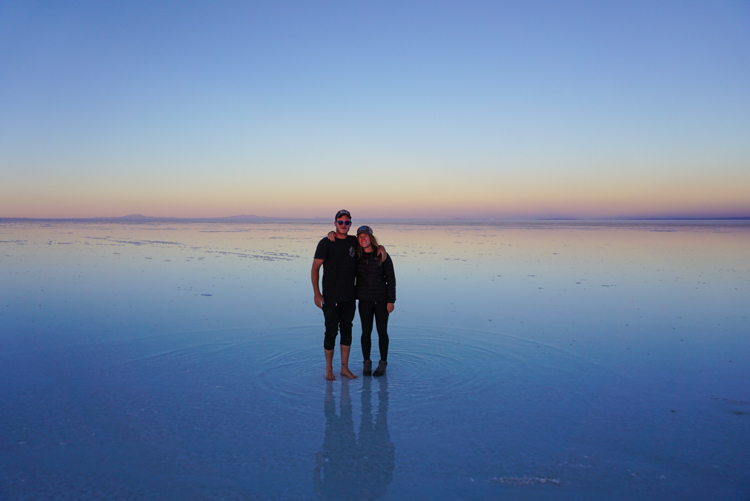
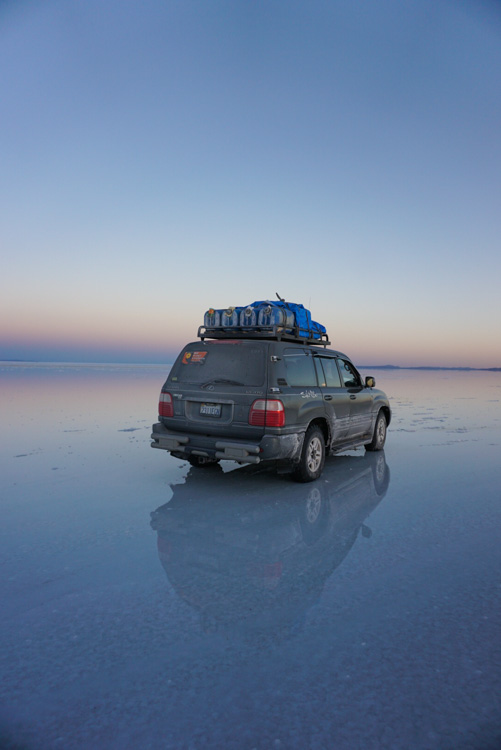
After a tasty dinner at the salt hotel, everyone has gone to bed but I’m desperate to make a ginger and honey tea. We have the honey, but we walk to the kitchen to ask if they’ve got ginger.
We absolutely butcher the pronunciation of “jengibre” (which is “hen-hee-bray”). Before I know it, three other staff members come out to help decipher what ingredient I’m asking for. They erupt in laughter when they realise.
When the hotel owner hands over some ginger, I ask if they’d like a cup for themselves. The six of us sip our tea while giggling about my Spanglish error. I feel excited to be sharing what is a common cold concoction for us back home, and I hope they think to make this next time someone is feeling unwell.
I was struggling with blocked sinuses and painful headaches, mostly from the illness I had at the time, but no doubt the altitude had a part to play.
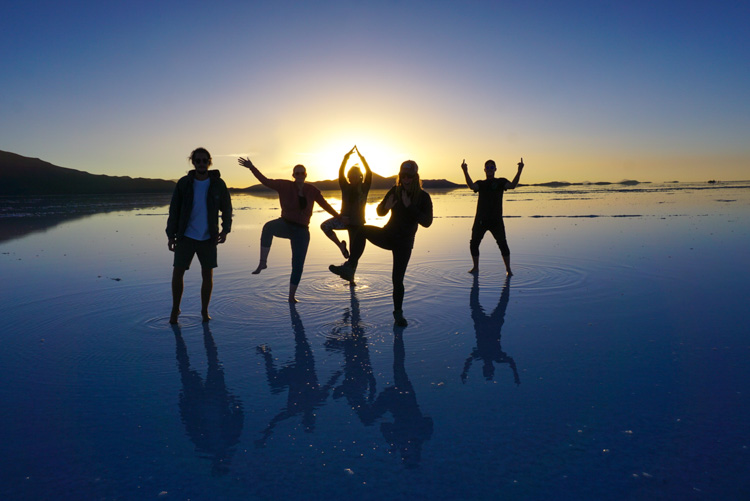
Day 2 on Bolivia’s Salt Flats tour: Lagoons, lagoons, more lagoons and some geysers
At 6:30am after a solid nights sleep we meet for breakfast. Hector announces we have a huge day ahead with lots of stops planned.
The sun hasn’t risen when I walk outside, and it looks like clouds are hovering above the horizon. But it’s not clouds, it’s mountains beyond the salt flats.
At 7:30am we leave the salt hotel for our first stop of the day, San Juan de Rosario (3,700m). At this quinoa farm we learn how they process quinoa inside a building made from petrified coral.
Hector asks the driver to pull over so we can admire the view over the salt flats as we start the incline and leave the salar behind.
Further down the road, we stop again beside what looks like a twig sticking out of the ground. “This is quinoa. You can take pictures.” He begins to demonstrate how to make flour with the dried seeds, and proceeds to take a selfie with the quinoa.
“Now we will look for sexy llamas”. At this point I’m unsure if Hector is joking.
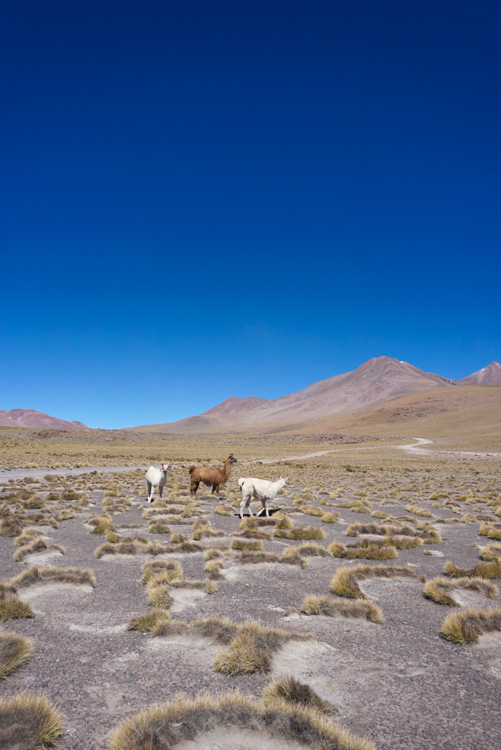
Quick round of facts if you’re still reading: Llamas have different colours and lots of wool. Vicunas are all brown and white, and are in danger of becoming extinct. Alpacas can’t be found in southern Bolivia as they require more water. They have more wool on the face compared to the llama.
We drive through a vast valley, sprinkled with rocks and small green shrubs. We stop to see an active volcano with white sprinkled on top. Hector tells us the white stuff is volcanic ash.
A few weeks earlier we’d been to Rainbow Mountain in Peru, and while we’re driving I see mountains in the distance that resemble those same landscapes. I’m not feeling fantastic in the car so at the time I don’t think to ask Hector any questions. A quick Google search and I now know I was looking at Seven Colours Mountain.
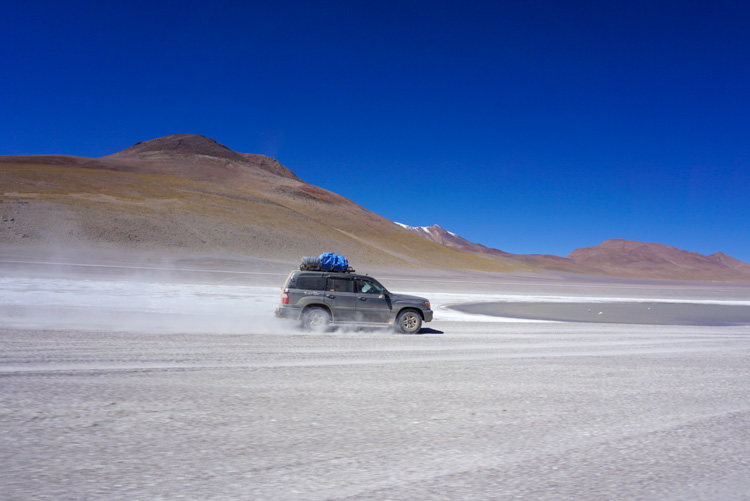
Next stop, Laguna Chulluncani at 4,438m above sea level. As I step out of the car, I quickly block my nose. It stinks here because of borax, which is used in the fertilising industry, or for glass and metals.
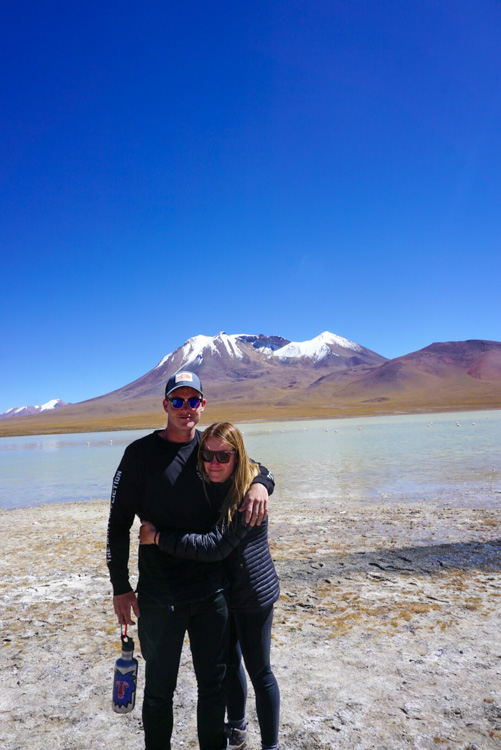
We stop for lunch in a beautiful desert landscape surrounded by volcanoes, where I see a small viscacha – a rare type of rodent that resembles a bunny rabbit – hiding behind some rocks. To stretch our legs after lunch we take a short hike up to 4,690m which we’re told could help with digestion.
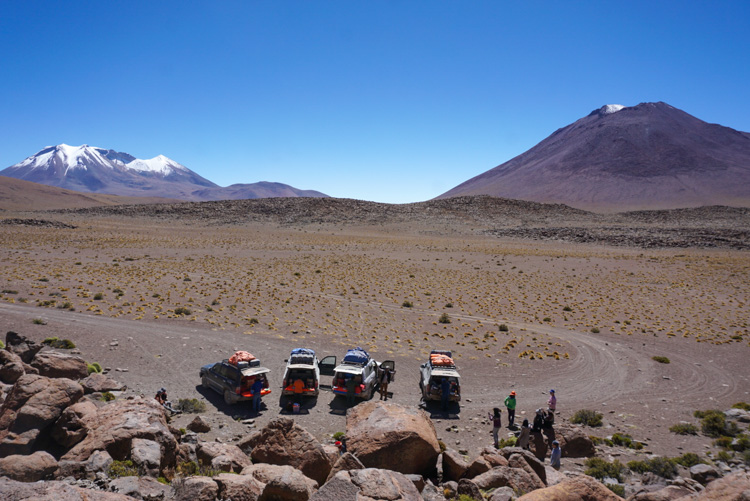
Siloli Desert
While crossing the Siloli desert I’m convinced we’re driving on the surface of Mars.
When we reach Laguna Cachi (4,470m) we stop to see more flamingos. Hector tells us about the three different species of flamingo, and how they build cone-shaped nests out of borax.
Next, we check out Laguna Kara (4,550m), but I stay in the car because I’m feeling unwell – and kind of lagooned out at this point.
For something different, our next stop is the stone tree (4,575m). These interesting rock formations have been eroded over many thousands of years.
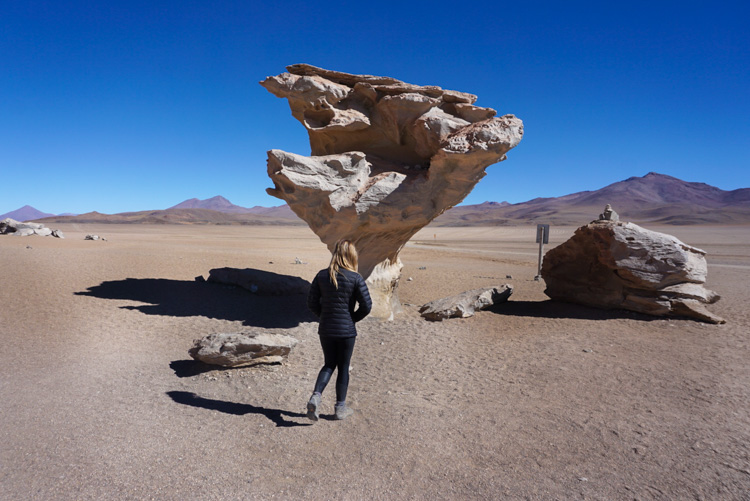
Laguna Colorada
At Laguna Colorada we each pay 150BOB each for entry to the region (4,350m). I am no longer lagooned out. The bright red colour of the lake and the intense blue sky leave me quiet with awe.
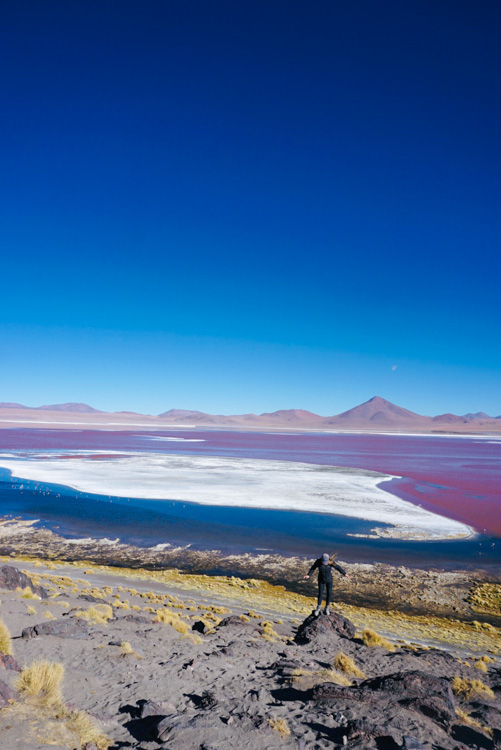
Colorada means “redish”. All lagoons depend on activity from the surrounding volcanoes. Hector tells us there’s lots of iron at the bottom of this lake. You can see red, orange and yellow, but it’s very shallow – about 30cm at the deepest point.
Here, we learn that flamingos can live for up to 30 years, and the Andean fox is their biggest predator.
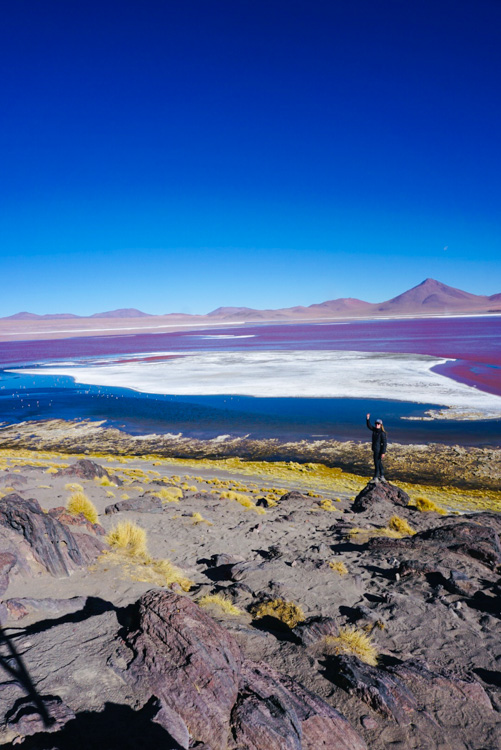
Geysers
Our next stop is exciting (and smelly). At 4,910m altitude, walking around takes the breath out of all of us, who are already struggling to breathe with the horrible smell. The geysers and mud pits are surrounded by mountains, and we learn that we’re in a huge volcanic crater.
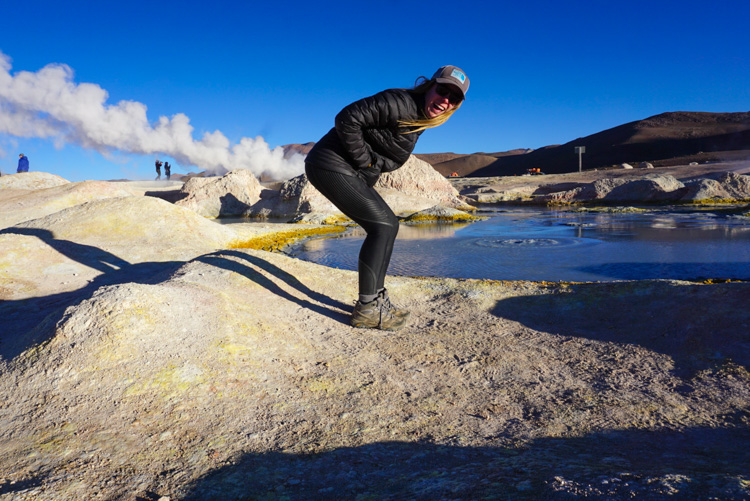
We were originally told the accommodation on night two is going to be ultra basic. To our surprise, it’s not bad at all. Long corridors lead to shared dorms with four beds in each room, and the shared bathrooms were nice.
That night we eat spaghetti, soup, and mystery meat for dinner. Nobody cares to ask what it is because it tastes good.
After dinner our tour group meets outside in the dark for a swim in the hot springs – except for me who is succumbing to whatever illness I have caught. Later, Mark tries to explain how magical the night sky was and I feel sad to have missed it.
Day 3 on Bolivia’s Salt Flats tour: Volcanoes, another lagoon or two and crossing the border into Chile
Fun fact. The 3 day salt flats tour is technically only a day and a half on the actual salt flats.
On the final day of our tour we have breakfast at 6:30am and watch another otherworldly sunrise outside. It’s pancakes, yogurt, museli and toast on the menu.
Our first stop on day three is the Salvador Dalí Desert.
Our final stop on the tour is Laguna Blanca and Laguna Verde (4,310m). Behind the lakes we can see 5,920m-high Volcan Licanbur which marks the border between Bolivia and Chile.
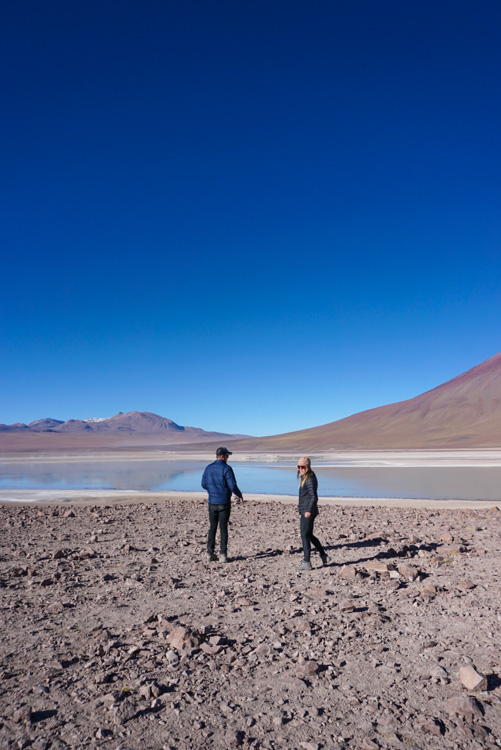
And that’s it. This is where we swap cars and one guide joins us for the journey to the border crossing, and the other guide goes back to Uyuni for those who are staying in Bolivia.
We wait in line at Bolivian migration, which is a small shack with very basic infrastructure, and then wait for our bus to be searched by Chilean customs, who are very thoroughly searching through each van. What feels like hours pass and we are finally given the green light to begin the 47km drive through “no man’s land”.
It’s immediately obvious we’re in another country when we arrive at Chile’s intricate customs building, where they search through all of our bags as though we are in an airport. Australians no longer have to pay the $120 entry fee to Chile, but you must obtain a visa before you get there.
Our next stop, the Atacama Desert.
TL;DR: Everything you need to know before touring Salar de Uyuni
Booking a tour: We chose Red Planet due to a large number of good reviews, and the price point seemed reasonable. We didn’t want to pay the cheapest amount and we didn’t have the budget to pay the most. In 2018, the tour cost us $175 AUD each. There are mixed reviews online, and I have read some reviews stating that drivers and tour guides were drunk for the 3 days. I did not see this happen. My story is a reflection on my experience, and this is not a sponsored post. We absolutely loved Hector the Protector and would recommend booking with this tour company if anyone asked. The cars were reliable (no breakdowns) and comfortable, and of course they are old and salty.
What’s the accommodation like? We actually loved the accommodation on our tour. The salt hotel was really cool, and the rooms were nice and spacious. Just remember to shower in the night, as the water is turned off in the mornings. On the second night the dorm rooms were clean and comfortable. It felt like a school camp eating in a large hall on long tables side by side. The opportunity to take a dip in the hot pools outside at night is spectacular.
What’s the food like? By Bolivian standards, the food was tasty. We enjoyed the meals. They weren’t groundbreaking, but we were always fed a sufficient amount and a nice variety was offered at each mealtime.
What to pack for the Salt Flats: We were continuing our trip to Chile after the Salt Flats so we brought all of our luggage with us. However, if you’re returning to La Paz after the 3 day tour, you will really only need the following:
- A decent camera (I have a Sony a6000) and a charger
- A random prop to use in perspective photos
- Cash
- Water bottle and snacks
- Warm clothing: thermal layers, long pants, warm jacket, waterproof/windproof jacket, long sleeved top, warm socks
- Swimmers
- Towel
- Hiking boots
- Easy to slip on shoes
- Toiletries (hand sanitizer, sunscreen, lip balm to protect your lips from the salty air)
- Personal medication
- Led lenser headlamp
Health and safety: You will be spending lots of time at high altitudes on this tour. There is minimal physical exercise as you will be spending the majority of time in the car driving long distances, but if you’re feeling unwell (like I was at the time), expect to feel even worse at such high altitudes (between 3,000-4,000m).
March 8, 2024
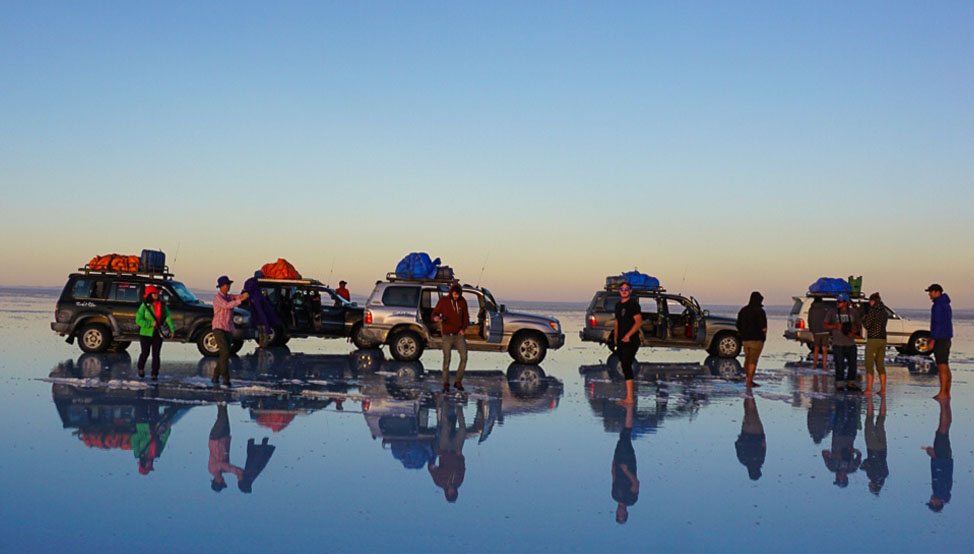
Hi! Thanks for the awesome review. I am looking to book the red planet tour and I was curious how you booked? Was it by texting them because it seems that is the only way to do it now but I am nervous if it is a scam.
Thanks!
Hey Cailey,
We were on the BoliviaHop bus when we made the booking through our guide onboard the bus.
I’d recommend dropping them an email, or using their contact form on their website: https://redplanet-expedition.com/three-days/
I hope this is helpful!
All the best,
Milly